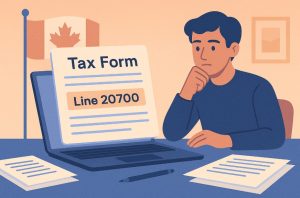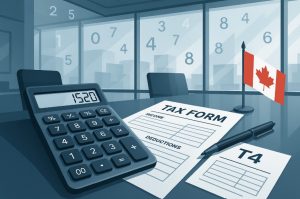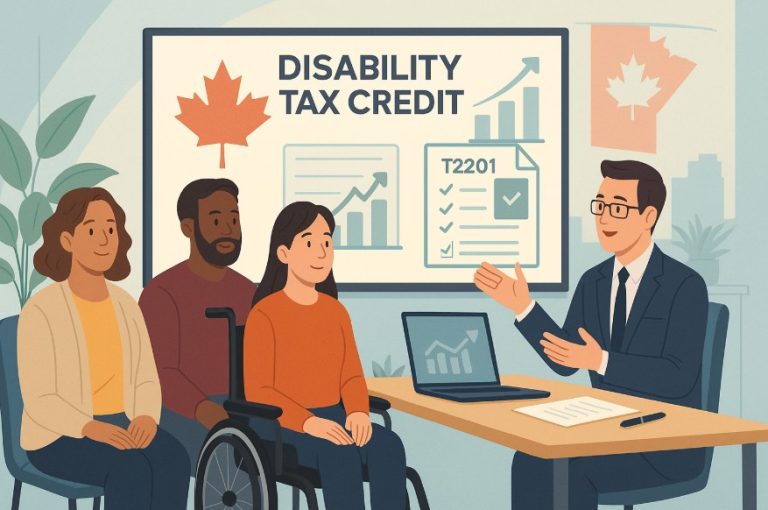Have you ever wondered how Line 20700 on your tax return affects your savings in Canada? Many Canadians file their taxes without fully understanding the deductions they’re entitled to, especially when it comes to retirement savings. Line 20700 plays a crucial role in reducing your taxable income through Registered Pension Plan (RPP) contributions, but it’s often overlooked or misunderstood.
By knowing how it works, you can avoid costly mistakes, claim your rightful deductions, and maximise your financial benefits. This article is here to break it all down in clear, simple terms.
You will learn what Line 20700 is, who can claim it, how to calculate it, and what contributions count. Get ready to take control of your tax return and feel confident about your retirement savings strategy.
What Is Line 20700 on a Tax Return?

Line 20700 on your Canadian tax return allows you to claim deductions for contributions made to a Registered Pension Plan (RPP). An RPP is an employer-sponsored pension plan registered with the Canada Revenue Agency (CRA) that helps employees save for retirement. By contributing to an RPP, you’re building your retirement nest egg and getting valuable tax relief.
The CRA allows you to deduct these contributions from your total income, effectively lowering the amount of income you are taxed on. This is why Line 20700 matters so much it directly reduces your tax liability. You’ll typically see your RPP contributions reported on your T4 slip (box 20) or T4A slip (box 032), and any additional contributions you made can also be claimed.
Some key points about Line 20700:
- It applies only to RPP contributions, not RRSP or TFSA amounts.
- It helps reduce your taxable income, not your gross income.
- Contributions must be within CRA limits to qualify.
Understanding Line 20700 helps you make sure you don’t leave money on the table during tax season.
Who Can Claim Line 20700?
You might be asking, “Am I eligible to claim Line 20700?” The good news is that if you’ve contributed to an RPP during the tax year, you likely qualify. However, there are important eligibility details you need to know to ensure you’re claiming it correctly.
The main requirement is that you were a member of an RPP registered with the CRA. This typically includes employees in the private sector, government workers, and certain union members whose employers offer pension plans. Self-employed Canadians, however, cannot claim Line 20700 because they generally do not participate in RPPs.
Key eligibility points include:
- RPP must be registered with CRA.
- Contributions must have been made during the tax year.
- You need to have official documentation like T4 or T4A slips.
Remember, not all pension plans qualify. Group RRSPs, foreign pension plans, and deferred profit-sharing plans (DPSPs) are not eligible under Line 20700. If you’re unsure, check with your plan administrator or a qualified tax professional. Knowing your eligibility upfront helps you claim the right deductions confidently.
How Do You Calculate Line 20700 Deduction?

Calculating your Line 20700 deduction is simpler than you might think, but it’s important to get it right. To begin, gather your T4 slips (look at box 20) and any T4A slips (check box 032). These boxes show the RPP contributions your employer deducted from your pay. If you made any additional voluntary contributions, include those as well.
Here’s a straightforward process:
- Add all RPP contributions from T4 and T4A slips.
- Include voluntary contributions paid directly to the RPP administrator.
- Check that the total does not exceed CRA’s maximum deduction limit (typically 18% of the previous year’s income).
For example, if your annual income was $60,000 and you contributed $5,000 through payroll plus $2,000 voluntarily, your total claim on Line 20700 would be $7,000. Ensure you don’t mix these up with RRSP contributions, those go on a separate line. Once calculated, enter the total on Line 20700 of your tax return. Double-check amounts to avoid common errors and attach supporting documents if needed.
What Contributions Count Toward Line 20700?
When you’re ready to claim Line 20700, it’s important to know exactly which contributions count. Let’s break this down.
Eligible Contributions to RPPs
The following are considered eligible:
- Contributions reported in box 20 on your T4 slip.
- Contributions in box 032 on your T4A slip.
- Additional voluntary RPP contributions paid directly.
These amounts are deductible as long as they were made to a pension plan registered with the CRA and within the same tax year.
What’s Excluded From the Deduction?
Not everything qualifies for Line 20700. For example:
- Contributions to RRSPs, TFSAs, or DPSPs.
- Foreign pension plans or unregistered pension plans.
- Amounts carried forward from past tax years if already claimed.
It’s crucial to review your statements carefully so you don’t mistakenly claim ineligible amounts.
CRA Rules to Follow
The CRA sets annual limits on how much you can deduct, typically based on 18% of your prior year’s earned income. Ensure you stay within these limits to avoid penalties or reassessments. Always retain receipts or proof of contributions in case CRA requests verification. Knowing what counts toward Line 20700 helps you file accurately and avoid costly mistakes.
How Does Line 20700 Impact Your Tax Savings?

You might wonder how Line 20700 actually benefits your wallet. Let’s break it down.
How Much Can You Save on Taxes?
By claiming RPP contributions on Line 20700, you reduce your taxable income. This means you pay tax on a smaller amount, lowering your overall tax bill. For example, if you earn $70,000 and contribute $5,000 to your RPP, your taxable income drops to $65,000.
Example of tax reduction for an average Canadian
Consider someone in the 29% marginal tax bracket. A $5,000 deduction could save them around $1,450 in taxes. That’s real money back in your pocket simply by reporting contributions you already made.
Long-term Retirement Benefits
Beyond immediate tax savings, contributing to an RPP builds future retirement security. You’re not just lowering today’s taxes, you’re investing in your future lifestyle. The combination of tax relief now and a stronger retirement plan later makes Line 20700 a smart financial move. Remember, the higher your income, the greater the potential savings from these deductions.
How Do You File Line 20700 on Your Tax Return?
Filing Line 20700 is straightforward when you know what to look for. Start by gathering all tax documents, especially your T4 and T4A slips, which show RPP contributions. Make sure to also collect receipts for any voluntary payments you made directly.
Next, total all eligible contributions and check that they fit within CRA’s deduction limits. On your tax return, report the total RPP contributions on Line 20700. If you’re filing online, most tax software will prompt you to enter these amounts.
Key filing tips:
- Double-check figures from your slips.
- Don’t mix RPP with RRSP or other retirement savings.
- Keep a copy of all documentation in case CRA requests it.
Finally, review your Notice of Assessment when it arrives to confirm the deduction was accepted. Filing Line 20700 correctly ensures you get the full tax benefit you’re entitled to.
What Are the Common Mistakes to Avoid With Line 20700?

Many taxpayers lose money or face reassessments by making simple errors on Line 20700. Avoid these to keep your tax return in top shape.
Misreporting contributions is a major issue. Always cross-check T4 and T4A slips and include only eligible RPP contributions. Overlooking pension adjustments is another common pitfall. Remember, CRA limits your deduction to 18% of prior-year income, adjusted for past service.
Missing employer statements can cause you to under-claim or over-claim. Without your T4 slip, you may miss contributions or misreport amounts.
Other mistakes include:
- Claiming ineligible pension plans like DPSPs or group RRSPs.
- Entering the wrong amounts or tax year.
- Forgetting voluntary contributions made directly.
Carefully reviewing your paperwork and understanding CRA rules can help you avoid these mistakes and keep your tax savings intact.
How Can You Maximise Your Line 20700 Claim?
To get the most from Line 20700, you need to be proactive. Start by contributing as much as you can within CRA limits. If your employer offers voluntary RPP contributions, consider topping up beyond the minimum.
Plan your pension contributions strategically, especially if you expect a high-income year. The more you contribute, the more you lower your taxable income.
Keep in mind:
- Review your pension adjustment to see available room.
- Track unused contribution room if applicable.
- Consult a tax professional if you’re unsure about maximising your deductions.
Finally, make sure you claim everything you’re eligible for, including direct contributions and amounts from your T4 and T4A slips. By staying informed and organised, you can fully leverage Line 20700 to strengthen both your tax position and your retirement future.
Conclusion
Understanding Line 20700 on your tax return is key to saving money today and securing your retirement tomorrow. By knowing what it is, who can claim it, how to calculate it, and how it impacts your taxes, you’re better equipped to file confidently.
Avoiding common mistakes and maximising your contributions ensures you get every dollar you deserve. Take time each year to review your paperwork, seek advice when needed, and claim your RPP deductions accurately. By doing so, you’re not just saving on taxes, you’re investing in peace of mind for the years ahead.
FAQs
You can claim contributions made to a registered pension plan reported on your T4 or T4A slip.
Where do I find my RPP contributions on my T4?
Look at box 20 on your T4 slip or box 032 on your T4A slip to find your RPP contributions.
Why is my Line 20700 deduction limited?
The CRA limits deductions based on 18% of prior-year income and pension adjustments to ensure fair contributions.
Do all pension plans qualify for Line 20700?
No, only RPPs registered with the CRA qualify foreign or unregistered plans are excluded.
Can I deduct RPP contributions if I leave my job?
Yes, you can deduct RPP contributions made before your job ended during that tax year.
What are common Line 20700 mistakes?
Common mistakes include misreporting amounts, claiming ineligible plans, or missing voluntary contributions.
Should I consult a tax professional for Line 20700?
If you’re unsure about eligibility or contributions, it’s wise to seek advice to maximise your claim.




